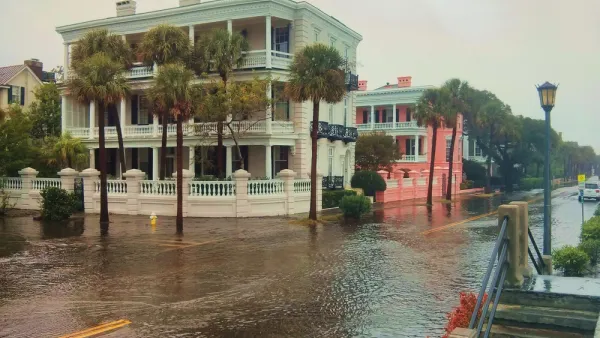William Brangham takes a look at Norfolk, Virginia, where rising sea levels have made major floods increasingly commonplace – and increasingly burdensome for taxpayers.
Perched on the southern shore of Virginia and perforated by an extensive network of inlets, the City of Norfolk is at the forefront of the battle between coastal cities and a rising sea. Norfolk has always been vulnerable to occasional inundation, but in recent years, floods causing major property damage have become a nearly annual occurrence.
For Norfolk, the shift in sea level is compounded by geological factors that have caused the land to sink at roughly the same rate as the water rises. Thus, what happens in Norfolk may well be a sign of things to come for coastal towns throughout the country.
The city has consulted firms in the Netherlands, where settlements have held close to waterways for centuries, for insight on how to manage the dilemma in coming years. The solutions they proposed (by no means permanent) could cost upwards of $300 million. Mayor Paul Fraim argues that the Navy, which has a strong presence in Norfolk, has a shared responsibility for the protection of the area.
Brangham argues that public policy, such as subsidized flood insurance, has much to do with waterfront development patterns. By maintaining such policies, he writes, the government softens the risk of building in untenable areas, at the expense of taxpayers everywhere. "The private insurance industry got out of writing flood policies in risky areas many years ago, and now the federal government is currently the biggest backstop for losses in flood-prone areas."
In the face of unyielding tides, Fraim has proposed "retreat zones" that would designate areas unfit for future development. "I'm not sure the community is ready for that, but in the next twenty or thirty years, there will be places in the city that will just contain water all the time, and we need to be prepared for that inevitability."
FULL STORY: Rising tide: Norfolk, Va., struggles on the front lines of sea-level rise [VIDEO]

Analysis: Cybertruck Fatality Rate Far Exceeds That of Ford Pinto
The Tesla Cybertruck was recalled seven times last year.

National Parks Layoffs Will Cause Communities to Lose Billions
Thousands of essential park workers were laid off this week, just before the busy spring break season.

Retro-silient?: America’s First “Eco-burb,” The Woodlands Turns 50
A master-planned community north of Houston offers lessons on green infrastructure and resilient design, but falls short of its founder’s lofty affordability and walkability goals.

Test News Post 1
This is a summary

Analysis: Cybertruck Fatality Rate Far Exceeds That of Ford Pinto
The Tesla Cybertruck was recalled seven times last year.

Test News Headline 46
Test for the image on the front page.
Urban Design for Planners 1: Software Tools
This six-course series explores essential urban design concepts using open source software and equips planners with the tools they need to participate fully in the urban design process.
Planning for Universal Design
Learn the tools for implementing Universal Design in planning regulations.
EMC Planning Group, Inc.
Planetizen
Planetizen
Mpact (formerly Rail~Volution)
Great Falls Development Authority, Inc.
HUDs Office of Policy Development and Research
NYU Wagner Graduate School of Public Service




























